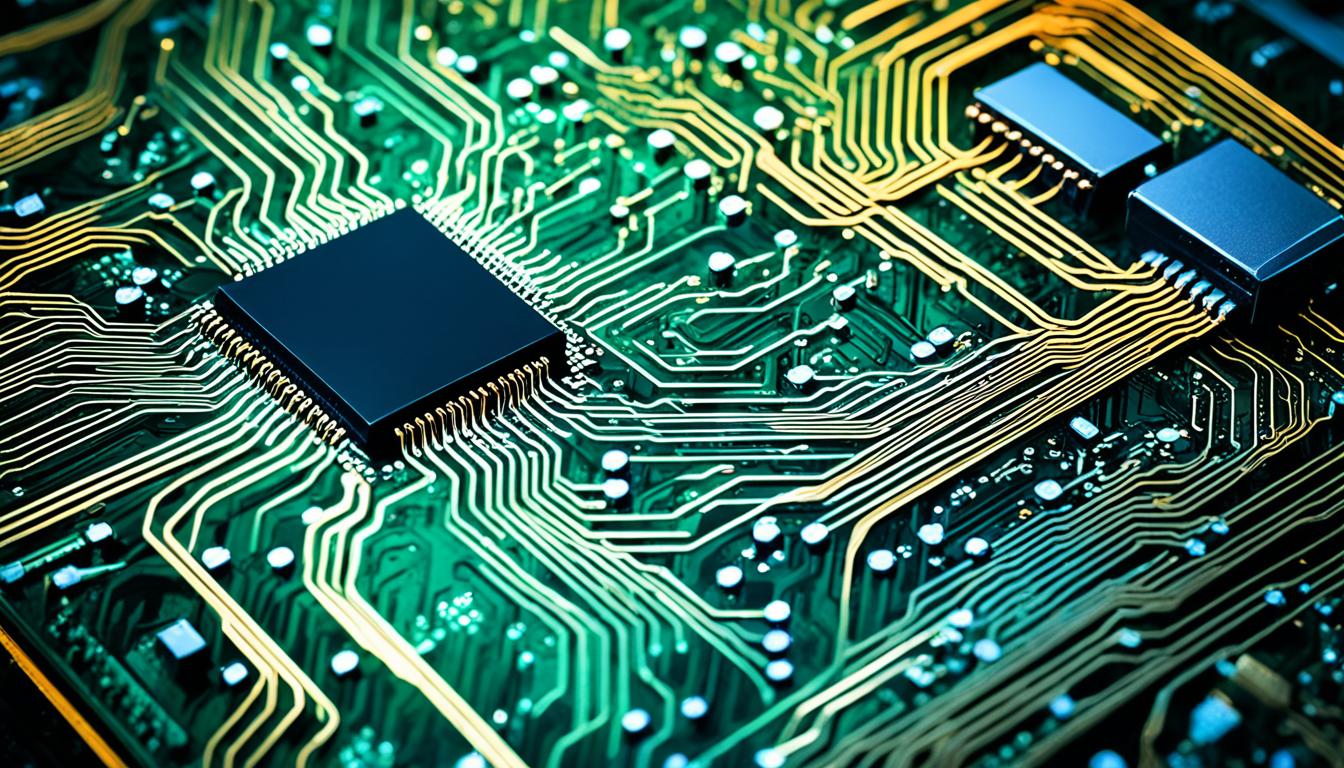Welcome to our comprehensive guide to Ethernet protocol interview questions for VLSI interviews. If you’re preparing for a networking-related role in India’s growing technology industry, you’ve come to the right place.
In this section, we will provide you with a curated list of interview questions that specifically focus on Ethernet protocol. Whether you’re a fresh graduate or an experienced professional, these questions will help you demonstrate your knowledge and skills in Ethernet networking to potential employers in the VLSI field.
By mastering these interview questions, you’ll be able to showcase your understanding of Ethernet protocol basics, the physical layer, the data link layer, and even the network layer and higher layers. This comprehensive knowledge will set you apart from other candidates and give you the confidence to excel in VLSI interviews.
So, let’s dive in and begin your preparation with our in-depth Ethernet protocol interview questions!
Table of Contents
Understanding Ethernet Protocol Basics
In this section, we will delve into the fundamental concepts of Ethernet protocol. A solid understanding of these basics is essential for anyone preparing for VLSI interviews in India’s thriving technology industry.
Overview of Ethernet Protocol:
Ethernet protocol is the standard set of rules and procedures that govern the transmission of data over Ethernet networks. It defines how data is organized, addressed, and transmitted between devices within a network.
Ethernet protocol is widely used in local area networks (LANs), providing a reliable and efficient means of communication between computers, servers, routers, and other networking devices.
Uses of Ethernet Protocol:
Ethernet protocol finds extensive application in various sectors, including enterprise networks, data centers, telecommunications, and even home networks. Its versatility and scalability make it a preferred choice for connecting devices and enabling seamless data transfer.
Whether you’re working in software development, network administration, or hardware design, having a solid grasp of Ethernet protocol basics is crucial.
The Principles behind Ethernet Protocol Operation
At its core, Ethernet protocol operates on the principles of data encapsulation and the use of unique MAC (Media Access Control) addresses. Data encapsulation involves wrapping the information to be transmitted within a standardized Ethernet frame structure.
Each Ethernet frame includes a source MAC address and a destination MAC address, which enables devices on the network to identify the intended recipient of the data.
When data is transmitted over an Ethernet network, it is divided into smaller units called frames. These frames are then transmitted over the network media, such as copper or fiber-optic cables, using specific signaling methods.
Ethernet protocol also incorporates collision detection and avoidance mechanisms to ensure efficient data transmission in shared network environments.
To further illustrate the fundamental concepts of Ethernet protocol, let’s take a look at a simplified representation of an Ethernet frame:
Components of an Ethernet Frame:
| Field | Description |
|---|---|
| Preamble | Contains a sequence of alternating 1s and 0s that synchronizes the receiving device’s clock with the transmitting device. |
| Start Frame Delimiter (SFD) | Marks the start of the Ethernet frame. |
| Destination MAC Address | Specifies the MAC address of the intended recipient. |
| Source MAC Address | Identifies the MAC address of the transmitting device. |
| EtherType | Indicates the higher-level protocol used in the encapsulated data. |
| Payload | Contains the actual data being transmitted. |
| Frame Check Sequence (FCS) | Ensures the integrity of the data by providing a checksum. |
These components work together to ensure reliable and efficient data transmission over Ethernet networks.
Ethernet Physical Layer Questions
In this section, we will discuss Ethernet physical layer questions that are commonly asked in VLSI interviews. Understanding the physical layer is essential for designing efficient and reliable Ethernet networks. Let’s explore some key topics related to the physical layer.
Different Ethernet Cable Types
The physical layer of Ethernet involves the transmission of data through various types of cables. Familiarize yourself with the characteristics and specifications of different Ethernet cable types, such as:
- Cat5e
- Cat6
- Cat7
- Fiber-optic cables
Signaling Methods
Ethernet uses different signaling methods to transmit data over cables. Gain knowledge about popular signaling methods, including:
- Baseband
- Broadband
- Manchester encoding
- 4B5B encoding
Transmission Media
The physical layer also involves the selection of appropriate transmission media for Ethernet networks. Learn about different transmission media options, such as:
- Twisted-pair copper cables
- Coaxial cables
- Fiber-optic cables
- Wireless transmission
By understanding these Ethernet physical layer questions, you will be well-prepared to answer interview questions related to the physical layer of Ethernet networks.

Ethernet Data Link Layer Questions
In this section, we will explore Ethernet data link layer questions that are commonly asked in VLSI interviews. These questions will examine your understanding of the Ethernet frame structure, MAC addresses, Ethernet switches, and protocols such as Ethernet II and IEEE 802.3.
Ethernet Frame Structure
1. Describe the structure of an Ethernet frame and its different fields.
2. How does the Ethernet frame ensure data integrity?
MAC Addresses
1. What is a MAC address, and how is it unique?
2. Explain the significance of MAC addresses in Ethernet networks.
Ethernet Switches
1. How do Ethernet switches improve network performance?
2. Compare and contrast the operation of a hub and a switch.
Ethernet II and IEEE 802.3
1. Differentiate between Ethernet II and IEEE 802.3 frame formats.
2. Which protocol is commonly used in modern Ethernet networks, and why?
These Ethernet data link layer questions will assess your knowledge of how data is transferred over Ethernet networks, helping you demonstrate your expertise during VLSI interviews.
Next, we will move on to Section 5, where we will cover Ethernet network layer and higher layer questions, providing you with a well-rounded understanding of Ethernet protocols.
Ethernet Network Layer and Higher Layer Questions
In this section, we will explore Ethernet network layer and higher layer questions that are commonly asked in VLSI interviews. Having a strong understanding of these concepts is crucial for demonstrating your expertise in Ethernet networking beyond the data link layer. Let’s dive in and explore some of the key topics:
IP Addressing
In the network layer, IP addressing plays a crucial role in identifying devices and facilitating communication between them. Here are some important questions related to IP addressing:
- Explain the difference between IPv4 and IPv6 addresses.
- What is subnetting? How does it help in IP address allocation?
- Discuss the purpose and functioning of DHCP (Dynamic Host Configuration Protocol).
Routing Protocols
Routing protocols are essential for determining the optimal path for data packets to reach their destination. Here are a few questions to test your knowledge in this area:
- Describe the difference between static and dynamic routing.
- What are some commonly used interior gateway protocols (IGP) and exterior gateway protocols (EGP)?
- Explain the concept of routing tables and how they are utilized in the network layer.
Network Devices
Understanding the role and functionality of network devices is crucial for managing and maintaining Ethernet networks. Here are questions to gauge your knowledge in this area:
- What is the purpose of a router in a network? How does it differ from a switch?
- Discuss the role of a firewall in network security.
- Explain the function of a proxy server in managing network traffic.
Ethernet Protocols: TCP/IP and UDP
The TCP/IP and UDP protocols are widely used in Ethernet networks for reliable and connectionless data transmission. Here are some questions to assess your understanding of these protocols:
- What are the main differences between TCP (Transmission Control Protocol) and UDP (User Datagram Protocol)?
- Discuss the three-way handshake process in TCP.
- When would you choose UDP over TCP for data transmission?
Ethernet Network Layer and Higher Layer Questions
Understanding the network layer and higher layer protocols in Ethernet is vital for VLSI interviews. By mastering topics such as IP addressing, routing protocols, network devices, and TCP/IP and UDP protocols, you will be well-prepared to tackle questions related to Ethernet networking beyond the data link layer.
| Topic | Sample Question |
|---|---|
| IP Addressing | What is the difference between IPv4 and IPv6 addresses? |
| Routing Protocols | Describe the concept of routing tables and their utilization in the network layer. |
| Network Devices | Explain the role of a firewall in ensuring network security. |
| Ethernet Protocols: TCP/IP and UDP | When would you choose UDP over TCP for data transmission? |
Mastering these Ethernet network layer and higher layer questions will enhance your preparation for VLSI interviews and demonstrate your expertise in the field. Keep in mind that understanding these concepts will be essential for navigating the complexities of Ethernet networking in the industry.

Conclusion
In conclusion, this comprehensive guide has provided you with a tailored set of Ethernet protocol interview questions specifically designed for VLSI interviews. By diligently studying and practicing these questions, you will be well-equipped to demonstrate your expertise in Ethernet networking during your VLSI job interviews in India.
As you prepare for your interviews, remember to focus on the basics of Ethernet protocol, including its uses and operating principles. Additionally, familiarize yourself with the physical layer, data link layer, and network layer of Ethernet, as well as higher layer concepts and protocols.
By showcasing your in-depth understanding of Ethernet protocol, you will position yourself as a strong candidate for networking-related positions in India’s growing technology industry. Good luck in your VLSI interviews!

